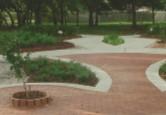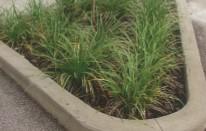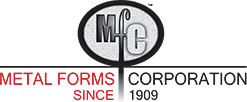Several Florida Cities are among the many U.S. municipalities that are using reusable polyethylene forms instead of lumber for sidewalks, curbs and other concrete projects. They have found that the forms save time and effort because they are strong, yet lighter to handle, easier to stake accurately, and suitable for straight or radius applications.
Casselberry
 At Casselberry, Streets, Fleet and Stormwater Maintenance Superintendent Glen Weatherholtz has found that Poly Meta Forms® outlast wood, improve productivity and are easier to use. These polyethylene forms are made by Metal Forms Corp. of Milwaukee, Wis.
At Casselberry, Streets, Fleet and Stormwater Maintenance Superintendent Glen Weatherholtz has found that Poly Meta Forms® outlast wood, improve productivity and are easier to use. These polyethylene forms are made by Metal Forms Corp. of Milwaukee, Wis.
Located north of Orlando, Casselberry has a year-round population of about 25,000, unlike many Florida cities that experience a dramatic seasonal change. Weatherholtz heads up a department that has broad responsibility for fleets and stormwater, as well as streets. When he took over the department more than five years ago, he brought a penchant for productivity and accountability.
“I don’t ask my men to work harder, just smarter,” Weatherholtz said. “My supervisors give me written weekly schedules of what their men are doing, and we put it in the computer. I push for accountability.”The same focus on results is evident in this choice of the reusable forms for all types of sidewalkrelated work in the city.
The polyethylene forms are moisture-resistant and will not rot, splinter or rust.
“If you use wood to make your forms, you’re lucky to get three uses before you have to replace them,” he said. “Lumber is getting expensive, and it warps and splits.” He ordered his first forms about three years ago and still uses the original forms and metal stake pockets. He says they are still in good shape and show no noticeable wear. “If I had a concrete business, I couldn’t buy enough of these forms.”
The choice has paid off in productivity. Weatherholtz said a concrete truck driver on one big job commented, “I deliver concrete to contractors’ jobs and government projects all over, and I’ve never seen people work concrete like your guys do.” On that job, a four-man crew poured 100 yards (10 loads of concrete) every other day for two weeks, setting the forms, pouring, and stripping as they went along. Considering the time out for trips to the lumberyard plus the time it took to set the wood forms, he thinks overall productivity has improved 300 percent to 400 percent using the new forms.
He also credits the combination of good grading and good forms. “The crew doesn’t have to work as hard to line up the forms when the grading is good, and they don’t have to pound in wooden stakes and nails. On sidewalks, they cut a template and one man marks the width. Two more follow stringing out the forms, and once the forms are in place, they set the stakes and they’re ready to pour.”
 Weatherholtz likes the polyethylene forms better than wood or metal in the Florida heat. His crew doesn’t need to use as much energy to handle them, and they stay cooler. “These don’t hold the heat, and they are lighter to handle.”
Weatherholtz likes the polyethylene forms better than wood or metal in the Florida heat. His crew doesn’t need to use as much energy to handle them, and they stay cooler. “These don’t hold the heat, and they are lighter to handle.”
Although the forms do not require backfilling, Weatherholtz explains that his crew generally backfill to the top of the form on sidewalks jobs. “It makes cleanup easier, and we don’t have to clean that stake pockets if concrete spills over the edge. After we strip the forms, it’s faster to put the sod in place too. I look for production, I look for efficiency and these forms give me that.”
Zephyrhills
In Zephyrhills, north of Tampa, the same polyethylene forms are being used for a variety of sidewalk and curb applications. Among the most interesting are landscaped curbed dividers at City Hall and sidewalk intersections with radiused corners.
Zephyrhills has a summer population of about 10,000 but swells to almost triple that in winter. Originally, the city only had sidewalks on the main streets, but miles of sidewalks have been added in the last several years. Street Supervisor Gregg Bricker said they are normally four inches thick but are poured six inches thick wherever a driveway crosses and eight inches thick at the edges of roads, to withstand the weight of garbage trucks and other traffic. His department previously formed with wood but has been using the Poly Meta Forms® for more than two years.
“We were constantly buying 2-by-4s, and we could only use them two or three times,” Bricker said. “I did a cost evaluation and found that the initial cost for wood was lower, but added expense of cutting stakes, scraping and cleaning boards and everything else cost more in the long run. We also weren’t getting the production we wanted because it took too long to put the forms in place. For curves, we would cut them to bend. We were looking for a better way.”
Bricker says the city agreed with his evaluation, and after he started using the new forms, productivity doubled almost immediately. “We went from pouring 10 yards a week using wood up to 20 yards, and now we are up to 30 yards.”
The ease of forming curves with the flexible forms is a big advantage for many of the jobs Bricker’s crew encounters.
“When you come to a telephone pole or fire hydrant, you can make a nice sweep around it. I’ve had many people complement our transitions and corners,” Bricker said. Curbs are another area where he thinks the forms have a big advantage over wood. Several landscaped dividers and islands in the city hall parking lot illustrate the smooth curves that would be difficult to form quickly using wood.
“Staking is much faster,” Bricker said, “and the stake pockets are easy to adjust. With 2-by-4s, if a stake cracks or breaks, you have to pull it out and put another one in. Wood stakes won’t go into hard ground very well, but the metal stakes go into practically anything. Cleanup is easier, too, he said. “We use a releasing agent and keep our old trowels to strip it off. With 2-by-4s, you sometimes catch a splinter, and they are harder to clean.”
Although the sidewalk and curb work is only a part of Bricker’s responsibility, he said he doesn’t bid out the sidewalk work. “You can’t get the quality we do,” he said.
“We take more time and care to build our sidewalks. Using these forms, the quality is good, the work is easier, and we get more production.”
Miramar
Miramar, near Miami, has a population of more than 100,000. Street Maintenance Supervisor Ron Garcia has used the polyethylene forms for more than three years for sidewalks as well as occasional other projects. He explains, “We do some slab work, for example if a utility wants to put up a 30-by-40 foot shed, but we use them mostly for sidewalks.” Last year, he said the city poured more than 7,000 feet of sidewalk.
Previously they used wood, Garcia said. “After a couple of times, the wood started falling apart. You can only put so many nails in it, and you have to use wooden stakes that can split.”
“The forms are easy to set up. They slide together and we don’t have to nail stakes in. With wood, you pound stakes in and, if it isn’t level or a stake breaks, you have to pound the nails out and start over. It’s time consuming, and you need nails and a saw to cut the wood. The metal stakes go right through everything, and they’re easier to drive.”
He also likes the removable metal stake pockets that can be placed wherever they are needed. “With them off, it is easier to stack and transport the forms that have the pockets welded in place, and we can just clean them up in a bucket.”
Many other Florida municipalities also use the Poly Meta Forms®, including Cape Coral, Daytona Beach, Del Ray, Deltona, Kissimee, Miami, St. Petersburg and Tallahassee.
